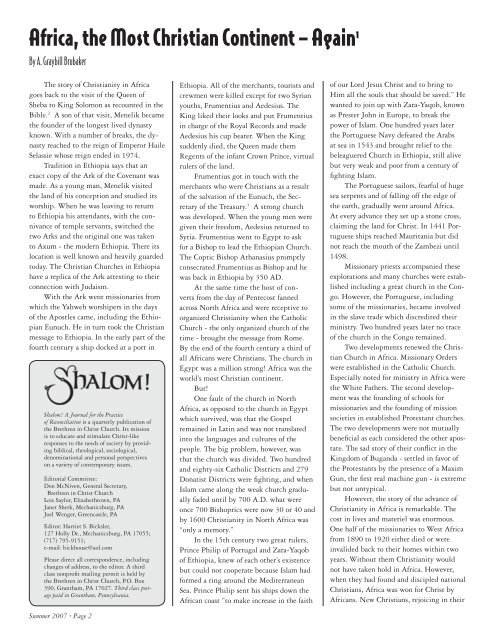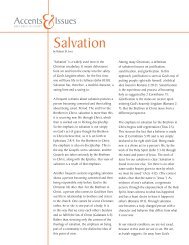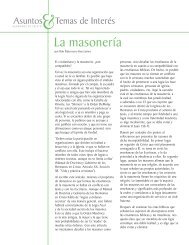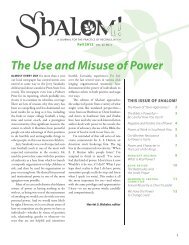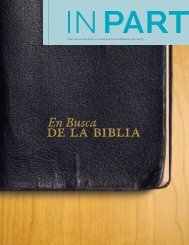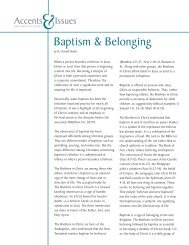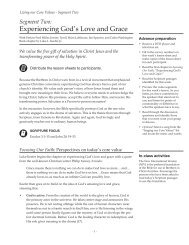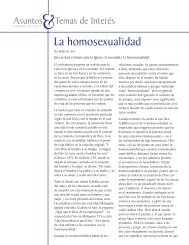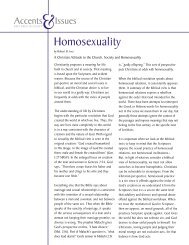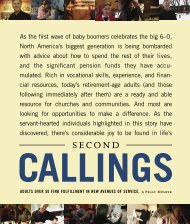Summer 2007 - Focus on Africa - Brethren in Christ Church
Summer 2007 - Focus on Africa - Brethren in Christ Church
Summer 2007 - Focus on Africa - Brethren in Christ Church
You also want an ePaper? Increase the reach of your titles
YUMPU automatically turns print PDFs into web optimized ePapers that Google loves.
<strong>Africa</strong>, the Most <strong>Christ</strong>ian C<strong>on</strong>t<strong>in</strong>ent – Aga<strong>in</strong> 1By A. Graybill BrubakerThe story of <strong>Christ</strong>ianity <strong>in</strong> <strong>Africa</strong>goes back to the visit of the Queen ofSheba to K<strong>in</strong>g Solom<strong>on</strong> as recounted <strong>in</strong> theBible. 2 A s<strong>on</strong> of that visit, Menelik becamethe founder of the l<strong>on</strong>gest lived dynastyknown. With a number of breaks, the dynastyreached to the reign of Emperor HaileSelassie whose reign ended <strong>in</strong> 1974.Traditi<strong>on</strong> <strong>in</strong> Ethiopia says that anexact copy of the Ark of the Covenant wasmade. As a young man, Menelik visitedthe land of his c<strong>on</strong>cepti<strong>on</strong> and studied itsworship. When he was leav<strong>in</strong>g to returnto Ethiopia his attendants, with the c<strong>on</strong>nivanceof temple servants, switched thetwo Arks and the orig<strong>in</strong>al <strong>on</strong>e was takento Axum - the modern Ethiopia. There itslocati<strong>on</strong> is well known and heavily guardedtoday. The <strong>Christ</strong>ian <strong>Church</strong>es <strong>in</strong> Ethiopiahave a replica of the Ark attest<strong>in</strong>g to theirc<strong>on</strong>necti<strong>on</strong> with Judaism.With the Ark went missi<strong>on</strong>aries fromwhich the Yahweh worshipers <strong>in</strong> the daysof the Apostles came, <strong>in</strong>clud<strong>in</strong>g the EthiopianEunuch. He <strong>in</strong> turn took the <strong>Christ</strong>ianmessage to Ethiopia. In the early part of thefourth century a ship docked at a port <strong>in</strong>Shalom! A Journal for the Practiceof Rec<strong>on</strong>ciliati<strong>on</strong> is a quarterly publicati<strong>on</strong> ofthe <strong>Brethren</strong> <strong>in</strong> <strong>Christ</strong> <strong>Church</strong>. Its missi<strong>on</strong>is to educate and stimulate <strong>Christ</strong>-likeresp<strong>on</strong>ses to the needs of society by provid<strong>in</strong>gbiblical, theological, sociological,denom<strong>in</strong>ati<strong>on</strong>al and pers<strong>on</strong>al perspectives<strong>on</strong> a variety of c<strong>on</strong>temporary issues.Editorial Committee:D<strong>on</strong> McNiven, General Secretary,<strong>Brethren</strong> <strong>in</strong> <strong>Christ</strong> <strong>Church</strong>Lois Saylor, Elizabethtown, PAJanet Sherk, Mechanicsburg, PAJoel Wenger, Greencastle, PAEditor: Harriet S. Bicksler,127 Holly Dr., Mechanicsburg, PA 17055;(717) 795-9151;e-mail: bickhouse@aol.comPlease direct all corresp<strong>on</strong>dence, <strong>in</strong>clud<strong>in</strong>gchanges of address, to the editor. A thirdclass n<strong>on</strong>profit mail<strong>in</strong>g permit is held bythe <strong>Brethren</strong> <strong>in</strong> <strong>Christ</strong> <strong>Church</strong>, P.O. Box390, Grantham, PA 17027. Third class postagepaid <strong>in</strong> Grantham, Pennsylvania.<str<strong>on</strong>g>Summer</str<strong>on</strong>g> <str<strong>on</strong>g>2007</str<strong>on</strong>g> • Page 2Ethiopia. All of the merchants, tourists andcrewmen were killed except for two Syrianyouths, Frumentius and Aedesius. TheK<strong>in</strong>g liked their looks and put Frumentius<strong>in</strong> charge of the Royal Records and madeAedesius his cup bearer. When the K<strong>in</strong>gsuddenly died, the Queen made themRegents of the <strong>in</strong>fant Crown Pr<strong>in</strong>ce, virtualrulers of the land.Frumentius got <strong>in</strong> touch with themerchants who were <strong>Christ</strong>ians as a resultof the salvati<strong>on</strong> of the Eunuch, the Secretaryof the Treasury. 3 A str<strong>on</strong>g churchwas developed. When the young men weregiven their freedom, Aedesius returned toSyria. Frumentius went to Egypt to askfor a Bishop to lead the Ethiopian <strong>Church</strong>.The Coptic Bishop Athanasius promptlyc<strong>on</strong>secrated Frumentius as Bishop and hewas back <strong>in</strong> Ethiopia by 350 AD.At the same time the host of c<strong>on</strong>vertsfrom the day of Pentecost fannedacross North <strong>Africa</strong> and were receptive toorganized <strong>Christ</strong>ianity when the Catholic<strong>Church</strong> - the <strong>on</strong>ly organized church of thetime - brought the message from Rome.By the end of the fourth century a third ofall <strong>Africa</strong>ns were <strong>Christ</strong>ians. The church <strong>in</strong>Egypt was a milli<strong>on</strong> str<strong>on</strong>g! <strong>Africa</strong> was theworld’s most <strong>Christ</strong>ian c<strong>on</strong>t<strong>in</strong>ent.But!One fault of the church <strong>in</strong> North<strong>Africa</strong>, as opposed to the church <strong>in</strong> Egyptwhich survived, was that the Gospelrema<strong>in</strong>ed <strong>in</strong> Lat<strong>in</strong> and was not translated<strong>in</strong>to the languages and cultures of thepeople. The big problem, however, wasthat the church was divided. Two hundredand eighty-six Catholic Districts and 279D<strong>on</strong>atist Districts were fi ght<strong>in</strong>g, and whenIslam came al<strong>on</strong>g the weak church graduallyfaded until by 700 A.D. what were<strong>on</strong>ce 700 Bishoprics were now 30 or 40 andby 1600 <strong>Christ</strong>ianity <strong>in</strong> North <strong>Africa</strong> was“<strong>on</strong>ly a memory.”In the 15th century two great rulers,Pr<strong>in</strong>ce Philip of Portugal and Zara-Yaqobof Ethiopia, knew of each other’s existencebut could not cooperate because Islam hadformed a r<strong>in</strong>g around the MediterraneanSea. Pr<strong>in</strong>ce Philip sent his ships down the<strong>Africa</strong>n coast “to make <strong>in</strong>crease <strong>in</strong> the faithof our Lord Jesus <strong>Christ</strong> and to br<strong>in</strong>g toHim all the souls that should be saved.” Hewanted to jo<strong>in</strong> up with Zara-Yaqob, knownas Prester John <strong>in</strong> Europe, to break thepower of Islam. One hundred years laterthe Portuguese Navy defeated the Arabsat sea <strong>in</strong> 1543 and brought relief to thebeleaguered <strong>Church</strong> <strong>in</strong> Ethiopia, still alivebut very weak and poor from a century offi ght<strong>in</strong>g Islam.The Portuguese sailors, fearful of hugesea serpents and of fall<strong>in</strong>g off the edge ofthe earth, gradually went around <strong>Africa</strong>.At every advance they set up a st<strong>on</strong>e cross,claim<strong>in</strong>g the land for <strong>Christ</strong>. In 1441 Portugueseships reached Mauritania but didnot reach the mouth of the Zambezi until1498.Missi<strong>on</strong>ary priests accompanied theseexplorati<strong>on</strong>s and many churches were established<strong>in</strong>clud<strong>in</strong>g a great church <strong>in</strong> the C<strong>on</strong>go.However, the Portuguese, <strong>in</strong>clud<strong>in</strong>gsome of the missi<strong>on</strong>aries, became <strong>in</strong>volved<strong>in</strong> the slave trade which discredited theirm<strong>in</strong>istry. Two hundred years later no traceof the church <strong>in</strong> the C<strong>on</strong>go rema<strong>in</strong>ed.Two developments renewed the <strong>Christ</strong>ian<strong>Church</strong> <strong>in</strong> <strong>Africa</strong>. Missi<strong>on</strong>ary Orderswere established <strong>in</strong> the Catholic <strong>Church</strong>.Especially noted for m<strong>in</strong>istry <strong>in</strong> <strong>Africa</strong> werethe White Fathers. The sec<strong>on</strong>d developmentwas the found<strong>in</strong>g of schools formissi<strong>on</strong>aries and the found<strong>in</strong>g of missi<strong>on</strong>societies <strong>in</strong> established Protestant churches.The two developments were not mutuallybenefi cial as each c<strong>on</strong>sidered the other apostate.The sad story of their c<strong>on</strong>flict <strong>in</strong> theK<strong>in</strong>gdom of Buganda - settled <strong>in</strong> favor ofthe Protestants by the presence of a MaximGun, the fi rst real mach<strong>in</strong>e gun - is extremebut not untypical.However, the story of the advance of<strong>Christ</strong>ianity <strong>in</strong> <strong>Africa</strong> is remarkable. Thecost <strong>in</strong> lives and materiel was enormous.One half of the missi<strong>on</strong>aries to West <strong>Africa</strong>from 1890 to 1920 either died or were<strong>in</strong>valided back to their homes with<strong>in</strong> twoyears. Without them <strong>Christ</strong>ianity wouldnot have taken hold <strong>in</strong> <strong>Africa</strong>. However,when they had found and discipled nati<strong>on</strong>al<strong>Christ</strong>ians, <strong>Africa</strong> was w<strong>on</strong> for <strong>Christ</strong> by<strong>Africa</strong>ns. New <strong>Christ</strong>ians, rejoic<strong>in</strong>g <strong>in</strong> their


